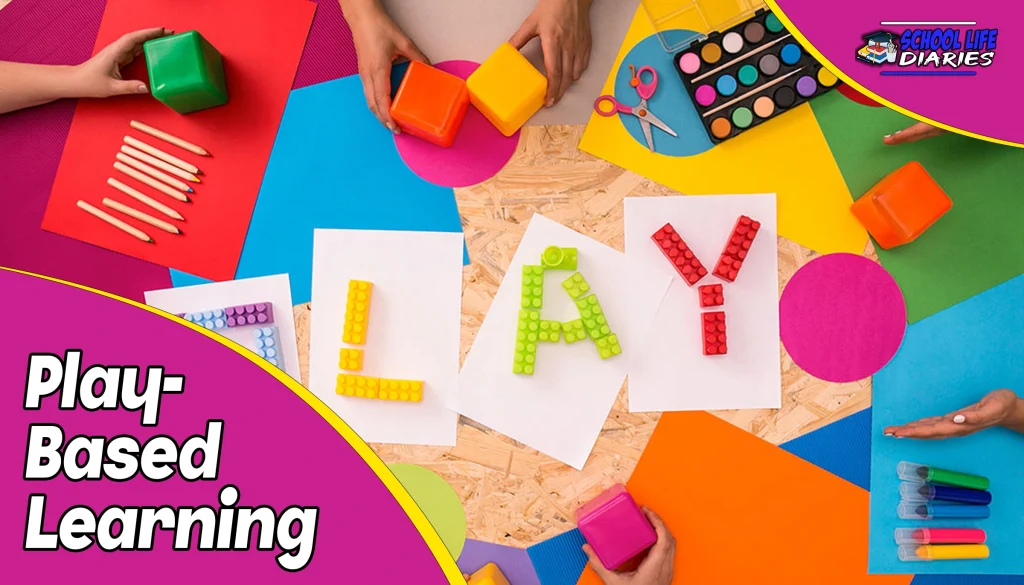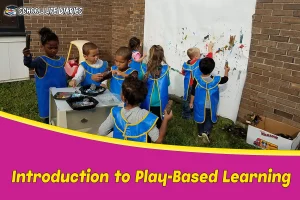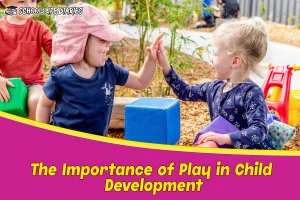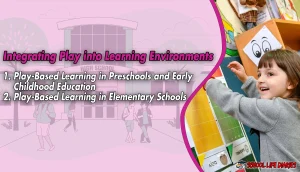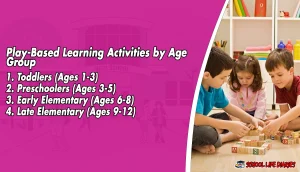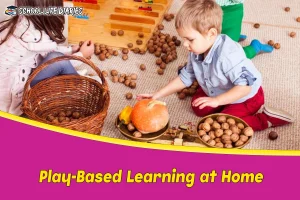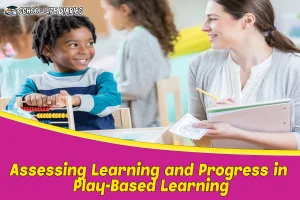Play-based learning is a powerful approach to education that taps into the innate curiosity and creativity of children. It recognizes the importance of play in their holistic development, allowing them to explore, experiment, and make sense of the world around them. By encouraging active engagement, problem-solving, and imaginative thinking, play-based learning unlocks a multitude of opportunities for children to learn and grow. Engaging with play-based learning activities allows children to develop a deep connection with their own learning process. It encourages them to take ownership of their education by offering choices and fostering intrinsic motivation.
Through playful interactions with peers and adults alike, children gain valuable life skills such as empathy, resilience, adaptability, and problem-solving abilities. As we delve into the world of play-based learning in this article ‘Unlocking the Power of Play-Based Learning: 20 Engaging Activities for Holistic Development,’ we will explore various age-appropriate activities that facilitate holistic growth while igniting a passion for lifelong learning.
Introduction to Play-Based Learning
Play-Based Learning is an educational approach that emphasizes the use of play as a means for children to learn and develop various skills. It recognizes the importance of play in child development, as it allows children to actively engage with their environment, explore new concepts, and make sense of the world around them.
What is Play-Based Learning?
To fully understand the concept of play-based learning, it is essential to recognize that it fosters a holistic approach to development by integrating various elements of cognitive, physical, and social skills. Play-based learning goes beyond traditional academic instruction and provides children with opportunities to explore their interests and engage in activities that promote creativity, problem-solving, and critical thinking. Through play, children also enhance their physical coordination and motor skills as they engage in active movement and manipulate objects. play-based learning promotes social skills by encouraging collaboration, communication, empathy, and conflict resolution among peers.
They provide guidance without imposing strict rules or predetermined outcomes on children’s activities. Instead of merely instructing students on what to learn or how to solve problems, teachers encourage independent thinking and allow children to take ownership of their learning experiences through play. Numerous studies have supported the effectiveness of play-based learning in promoting holistic development among children. Research has consistently shown that when compared to more structured forms of education, such as rote memorization or direct instruction methods prevalent in traditional classrooms; play-based approaches lead to better academic outcomes as well as improved social-emotional skills development for young learners.
The Importance of Play in Child Development
The incorporation of play into a child’s daily routine has been shown to have significant positive effects on their overall growth and maturation. Play allows children to explore their creativity, which is essential for their cognitive development. When engaged in play, children have the freedom to use their imagination and come up with unique ideas. This creative thinking helps them develop problem-solving skills as they find innovative ways to overcome obstacles and challenges that arise during play. In this way, play not only enhances creativity but also fosters critical thinking and analytical abilities. Engaging in playful activities promotes self-confidence and resilience as children learn to handle setbacks or failures during play experiences.
Encouraging risk-taking and experimentation within a safe environment, play nurtures the emotional well-being of children while promoting personal growth. Incorporating play into a child’s daily routine is crucial for holistic development. Play stimulates creativity by encouraging imaginative thinking and problem-solving skills. It also supports emotional development by providing opportunities for self-expression, empathy-building, and building resilience. As parents or educators recognize the importance of play in child development, they can create environments that foster exploration, curiosity, and freedom of expression – ultimately empowering children throughout their developmental journey.
Play vs. Traditional Learning: Understanding the Differences
Understanding the distinctions between play and traditional learning is essential in comprehending the different approaches to education. Play-based learning, as the term suggests, involves using play as a means of teaching and learning. It focuses on creating a fun and engaging environment where children can explore, experiment, and discover new ideas and concepts. This approach recognizes that children learn best when they are actively involved in their own learning process. Play based learning offers several benefits for holistic development.
Play-based learning can be implemented in various settings such as schools, childcare centers, or even at home.
In schools, teachers can incorporate hands-on activities into their lesson plans to make them more engaging for students. Childcare centers can create play areas with age-appropriate toys and materials promoting exploration and discovery. Even at home, parents can encourage play-based learning by setting aside dedicated time for unstructured play where children can freely express themselves. Moreover, play based learning also plays a crucial role in emotional development. Through pretend play or role-playing games, children have the opportunity to understand different emotions and learn how to regulate their own feelings effectively.
Benefits of Play-Based Learning
This paragraph will discuss the benefits of play-based learning, specifically focusing on cognitive, social, and physical benefits. Play-based learning has been found to have numerous cognitive benefits for children. Through play, children are able to develop problem-solving skills, enhance their creativity and imagination, and improve their critical thinking abilities. Additionally, play-based learning also promotes social skills development by allowing children to engage in cooperative play, learn how to take turns, share resources, negotiate conflicts and develop empathy towards others.
Cognitive Benefits
Enhancing cognitive abilities through play-based learning activities can foster a sense of curiosity and intellectual growth in children. Play is not just an enjoyable pastime for children; it also serves as a powerful tool for their brain development. When children engage in play, they are actively using their brains to explore, problem-solve, and make sense of the world around them. This process stimulates various areas of the brain responsible for cognition, such as memory, attention, and executive functions.
Learning through play provides numerous cognitive benefits for children. It allows them to develop critical thinking skills by encouraging them to analyze situations, come up with creative solutions, and make decisions independently. Through imaginative play scenarios or puzzles, children learn how to think flexibly and adapt their strategies accordingly. Additionally, play-based learning promotes memory retention as children actively engage with information during pretend play or interactive games.
Social Benefits
Social benefits can be derived from play-based learning as it promotes the development of important interpersonal skills and fosters positive social interactions among children. Through playful activities, children are given the opportunity to practice and enhance their emotional skills, such as empathy, self-regulation, and emotional intelligence. They learn to understand and manage their own emotions, as well as recognize and respond to the feelings of others. This not only helps in building healthy relationships but also contributes to their overall well-being.
These experiences help them develop effective communication skills and build strong connections with their peers. Moreover, play-based learning promotes teamwork and collaboration among children. Through collaborative play activities or group projects, children learn how to work together towards a common goal. They acquire essential skills like problem-solving, decision-making, negotiation, compromise, and leadership qualities. These experiences not only prepare them for future endeavors but also instill a sense of belongingness and cooperation within a group setting.
Physical Benefits
Physical development is an essential aspect of a child’s overall growth and plays a crucial role in their ability to navigate the world around them. Play-based activities, such as running, jumping, climbing, and throwing, provide children with opportunities to engage in active movement. These activities not only help in burning excess energy but also contribute to the development of strong muscles and bones.
Activities like crawling under obstacles or playing tag require children to use their arms and legs together while maintaining balance. By engaging in such physical activities during playtime, children strengthen their core muscles and improve their overall body control. Play based learning offers numerous physical benefits for children’s holistic development. It promotes active movement which aids in building strong muscles and bones while also improving coordination skills. Furthermore, it enhances gross motor skills by allowing children to engage in whole-body movements during various play activities. Incorporating play into education not only supports academic growth but also contributes significantly to a child’s physical well-being.
Integrating Play into Learning Environments
This discussion will focus on the integration of play into learning environments, specifically in preschools and early childhood education as well as elementary schools. Play-based learning has been widely recognized for its benefits in promoting holistic development among young learners. By incorporating play into these educational settings, educators can create engaging and effective learning experiences that foster cognitive, social, emotional, and physical growth in children.
Play-Based Learning in Preschools and Early Childhood Education
Through engaging in play, children can enhance their problem-solving abilities, creativity, and critical thinking skills as they navigate various scenarios and challenges. Implementing play-based learning requires careful planning by educators to create an environment that supports exploration and discovery. It involves providing a range of materials and resources that encourage imaginative play, such as blocks, art supplies, dramatic play props, and outdoor spaces for physical activities.
They observe the children’s interests and engage in purposeful conversations that stimulate their thinking while allowing them to lead the direction of the play. Play-based learning is not limited to preschools; it can be implemented across different educational settings for young learners. In early childhood education programs like kindergarten or daycare centers, incorporating elements of play into the curriculum can help create a more engaging environment for children to learn essential skills. Similarly, primary schools can integrate playful activities into lessons to make them more enjoyable while promoting active participation from students.
Play-Based Learning in Elementary Schools
Incorporating play into elementary school education allows for a more dynamic and interactive learning environment that promotes the acquisition of essential skills. Play-based learning in elementary schools can help students develop critical thinking, problem-solving, and social-emotional skills. One significant challenge is ensuring that teachers are adequately trained to effectively incorporate play-based activities into their curriculum. Teachers need to understand how to create meaningful play experiences that align with educational goals while allowing students to explore and discover knowledge independently.
Professional development programs can provide teachers with the necessary training and support to design engaging play-based lessons that cater to different learning styles and abilities. Another challenge is parental involvement in supporting play-based learning at home. Parents may not fully understand the benefits of play in education or may prioritize academic achievement over playful exploration. Educators need to communicate the importance of play-based learning to parents and provide them with resources to engage their children in purposeful play outside of school hours. This approach creates an environment where students are motivated, actively engaged, and able to develop a range of skills essential for their holistic development.
Play-Based Learning Activities by Age Group
This discussion will focus on play-based learning activities for different age groups, including toddlers (ages 1-3), preschoolers (ages 3-5), early elementary students (ages 6-8), and late elementary students (ages 9-12). These activities are designed to promote holistic development in children and can be integrated into various learning environments.
Toddlers (Ages 1-3)
Toddlers between the ages of 1 and 3 experience a transformative period of growth and development that can be effectively nurtured through purposeful engagement in various activities. One important aspect of play-based learning for toddlers is sensory exploration. At this age, toddlers are curious about the world around them and use their senses to understand their environment. Engaging them in activities that involve touch, taste, smell, sight, and sound not only stimulates their senses but also enhances their cognitive and emotional development.
Language development is another crucial area that can be fostered through play-based learning during the toddler years. Toddlers start to understand and communicate using words during this stage of development. Engaging them in language-rich activities such as singing songs, reading books aloud, or engaging in pretend play helps expand their vocabulary, improves their listening skills, and encourages early literacy skills. Additionally, incorporating gestures or signs into these activities can support communication for toddlers who may not yet have developed full verbal skills.
Preschoolers (Ages 3-5)
Preschoolers between the ages of 3 and 5 embark on a pivotal stage of growth and development that can significantly shape their future academic and social success. This is the age when children are eager to explore, discover, and learn about the world around them. Play-based learning activities provide an ideal platform for preschoolers to engage in holistic development. One of the key benefits of play-based learning is its ability to foster creativity and imagination in preschoolers.
Through open-ended play activities such as building blocks or pretend play, children are encouraged to think critically, problem-solve, and express themselves freely. These activities not only stimulate their imagination but also enhance their communication skills as they interact with peers during collaborative play. Moreover, play-based learning allows preschoolers to develop essential life skills such as self-regulation and empathy. When engaged in group games or role-playing scenarios, children learn how to manage their emotions effectively while considering others’ perspectives.
Early Elementary (Ages 6-8)
Early elementary students, typically between the ages of 6 and 8, begin a new phase in their educational journey that builds upon the foundational skills they developed during their preschool years. At this stage, play-based learning strategies prove to be highly effective teaching methods for these young learners. Engaging in educational activities not only captures their attention but also promotes holistic development. play-based learning strategies provide early elementary students with opportunities to explore and discover new concepts in a fun and interactive manner.
Through games, puzzles, and hands-on activities, children are able to grasp abstract ideas such as math concepts or scientific principles in a more concrete way. These strategies allow them to actively engage with the material and make connections between what they already know and what they are learning. Engaging in educational activities further supports the overall growth of early elementary students by fostering creativity and imagination. Art projects, storytelling exercises, or drama performances enable children to express themselves freely while honing their communication skills. These activities empower them to think outside the box and approach challenges from different perspectives.
Play-based learning strategies are highly effective teaching methods for early elementary students aged 6-8. Incorporating engaging educational activities into their curriculum allows these young learners to actively participate in their own education while promoting holistic development across various domains – cognitive, social-emotional, physical, and creative. By creating an environment that encourages exploration and freedom within structured boundaries, educators can unlock the power of play-based learning for these eager minds.
Late Elementary (Ages 9-12)
Late elementary students, typically between the ages of 9 and 12, enter a new phase in their educational journey that builds upon the foundational skills they developed during their earlier years. At this stage, engaging projects become a valuable tool for promoting holistic development. These projects allow students to explore various subjects in a hands-on manner, encouraging curiosity and critical thinking. For example, interactive games can be used to teach important concepts in math or science. By incorporating elements of play into their learning experience, students are more likely to stay engaged and retain information.
Collaborative challenges also play a significant role in the late elementary classroom. These challenges encourage teamwork and communication among students while developing problem-solving skills. Whether it’s building structures with blocks or solving puzzles together, these activities foster an environment where students can learn from one another and improve their social skills simultaneously.
Play-Based Learning for Special Education and Inclusive Classrooms
Inclusive classrooms can benefit greatly from the implementation of play-based learning strategies, especially in the context of special education. Special education adaptations that incorporate play-based accommodations can create a more inclusive and engaging learning environment for students with diverse needs. By incorporating play into their lessons, teachers can provide opportunities for students to develop important skills while also fostering a sense of belonging and autonomy.
One effective strategy for promoting inclusion in the classroom is to use play-based activities that are designed to meet the specific needs of students with disabilities. For example, teachers can modify traditional games or activities to ensure that all students can participate and contribute. This may involve providing additional support or adapting materials to make them more accessible. By doing so, teachers not only address the unique challenges that students with disabilities may face but also create an inclusive atmosphere where all students feel valued and included.
Overall, incorporating play-based learning strategies into special education settings promotes inclusion by providing opportunities for all students to actively engage in their learning. By making adaptations and accommodations as needed, teachers create an environment where every student feels supported and empowered. Through these efforts, inclusive classrooms become spaces where diversity is celebrated, barriers are broken down, and all learners have the opportunity to thrive academically and socially.
Play-Based Learning at Home
One effective approach to incorporating play-based learning at home involves creating a structured and supportive environment that encourages exploration, creativity, and problem-solving skills. By seamlessly integrating play into daily routines, parents can provide their children with opportunities for growth and development while still maintaining a sense of structure. For example, during mealtime, parents can engage their children in simple cooking activities that encourage them to measure ingredients or think critically about different flavors. This not only fosters their creativity but also enhances their problem-solving abilities as they navigate through the process.
Creating a play-friendly environment is another essential aspect of incorporating play-based learning at home.This can be achieved by designating specific areas or spaces within the home where children are encouraged to engage in imaginative play or hands-on activities. These areas can be stocked with age-appropriate toys, art supplies, books, and other materials that promote exploration and discovery. Incorporating play-based learning at home also involves encouraging independent thinking and decision-making.
Overall, incorporating play-based learning at home requires creating a structured yet flexible environment that nurtures exploration and creativity while promoting problem-solving skills. By incorporating play into daily routines, creating a play-friendly environment with open-ended materials, and fostering independent thinking and decision-making skills, parents can unlock the power of play-based learning for holistic development in their children’s lives.
Play-Based Learning in Online and Remote Education
Another aspect to consider in the realm of play-based learning is its application in online and remote education. With the increasing use of technology in classrooms, educators are finding new ways to engage students virtually. Online play provides a platform for interactive learning experiences that can be accessed remotely. This allows students to participate in educational activities from the comfort of their own homes, making learning more accessible and convenient.
In remote education, play-based learning offers a unique opportunity for virtual engagement. Through gamification techniques, educators can create interactive and immersive experiences that captivate students’ attention and foster active participation. For example, online quizzes or games can be used as assessment tools while also providing an engaging and enjoyable experience for students. By incorporating elements of play into remote education, educators can enhance student motivation and promote a deeper understanding of the subject matter.
Virtual platforms allow for real-time communication and teamwork even when physically separated. Educational games or simulations that require cooperation between participants encourage social interaction and problem-solving skills development. Additionally, these activities provide a sense of community within the virtual classroom environment, fostering connections among students who may not have had the opportunity to interact otherwise.
Moreover, it promotes collaboration by encouraging social interaction and teamwork among participants.
Assessing Learning and Progress in Play-Based Learning
Assessing the effectiveness of play-based learning methods requires careful evaluation of students’ learning outcomes and progress. In order to accurately assess progress, educators need to establish clear learning goals and objectives for each activity or play session. These goals should align with the holistic development areas that play-based learning aims to address, such as cognitive, social-emotional, physical, and language development. By setting specific objectives, educators can track students’ progress and determine whether they are meeting the desired outcomes.
One effective way to evaluate the effectiveness of play-based learning is through ongoing observation and documentation. Educators can observe students during play activities and take notes on their interactions, problem-solving skills, communication abilities, and overall engagement. This qualitative data can provide valuable insights into students’ development in different areas. It is important for educators to create a systematic approach to record observations consistently over time.
Assessing progress in play-based learning involves evaluating students’ learning outcomes and tracking their development across various domains. This requires educators to establish clear goals for each activity, engage in ongoing observation and documentation of student behavior during play sessions, as well as implement formative assessments that encourage playful demonstrations of understanding. By employing these assessment strategies effectively, educators can gain valuable insights into the effectiveness of play-based learning methods while ensuring that children experience holistic development in an engaging and meaningful manner.
Challenges and Solutions in Play-Based Learning
Challenges in implementing play-based learning methods can arise due to the need for careful planning, teacher training, and creating a supportive learning environment. Play-based learning requires educators to carefully plan and design activities that align with specific learning goals while allowing children to explore and experiment. This can be challenging as it requires teachers to strike a balance between providing structure and guidance while also allowing for child-led exploration.
Another challenge in play-based learning is creating a supportive learning environment. Play-based learning encourages active engagement, collaboration, and problem-solving among children. However, creating an environment that fosters these skills can be difficult. Teachers must ensure that materials and resources are accessible to all students and encourage open-ended exploration. They must also foster positive relationships among students and create an atmosphere of trust where children feel comfortable taking risks and making mistakes.
Collaborative planning sessions with other educators can also be beneficial as they provide an opportunity for sharing ideas and strategies. Creating a supportive learning environment involves establishing clear expectations for behavior during playtime and providing consistent support throughout the process. Teachers should regularly assess the progress of their students through observation or documentation of their play experiences.
Conclusion
To successfully implement play-based learning, educators must prioritize careful planning, teacher training, and creating a supportive learning environment. Challenges in play-based learning arise from the need to strike a balance between structured activities and allowing children the freedom to explore and learn through play. Educators should carefully plan activities incorporating educational objectives and opportunities for open-ended exploration. This requires a deep understanding of child development and the ability to adapt activities to meet individual needs.
Assessing play-based learning can be challenging due to its non-traditional nature. Unlike traditional teaching methods that rely on assessments such as tests or quizzes, play-based learning focuses on processes rather than outcomes. Combining play-based learning with traditional teaching methods can enhance the overall learning experience. While play allows for creativity, imagination, and self-expression, traditional teaching methods provide structure and facilitate the acquisition of specific knowledge or skills. Integrating both approaches can help ensure a well-rounded education that meets academic standards while also promoting holistic development.

